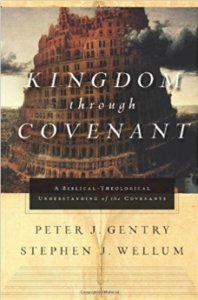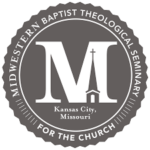Gentry, Peter J., and Stephen J. Wellum. Kingdom through Covenant: A Biblical-Theological Understanding of the Covenants. Wheaton, IL: Crossway, 2012.
Peter Gentry and Steve Wellum have produced the most extensive study of the biblical covenants published in over a century, arguing for what they call Progressive Covenantalism, a middle-way between Dispensationalism and Covenant Theology. DeRouchie favorably but critically reviewed this book in the Bulletin of Biblical Research after using it as a text book in his 4th year MDiv biblical theology course. You can find a pdf of the review here, or you can read it below.
*****
Table of Contents:
Preface
List of Abbreviations
PART ONE: Prolegomena
1. The Importance of Covenants in Biblical and Systematic Theology
2. Covenants in Biblical-Theological Systems: Dispensational and Covenant Theology
3. Hermeneutical Issues in “Putting Together” the Covenants
PART TWO: Exposition of the Biblical Covenants
4. The Notion of Covenant in the Bible and in the Ancient Near East
5. The Covenant with Noah
6. The Covenant with Creation in Genesis 1–3
7. The Covenant with Abraham (I)
8. The Covenant with Abraham (II)
9. The Israelite (Mosaic) Covenant: Exodus
10. The Israelite (Mosaic) Covenant: Deuteronomy
11. The Davidic Covenant
12. The New Covenant: Introduction/Isaiah/Ezekiel
13. The New Covenant: Jeremiah
14. The New Covenant in Daniel’s Seventy Weeks
15. Speak the Truth in Love (Ephesians 4:15): Life in the New Covenant Community
PART THREE: Theological Integratioin
16. “Kingdom through Covenant”: A Biblical-Theological Summary
17. “Kingdom through Covenant”: Some Theological Implications
Appendix: Lexical Analysis of běrît (בְּרִית)
Bibliography for Parts 1 and 3
Bibliography for Part 2
General Index
Scripture Index
Publisher’s Description:
The disciplines of biblical and systematic theology join forces to investigate anew the biblical covenants and the implications of such a study for conclusions in systematic theology. By incorporating the latest research from the ancient Near East and examining implications of their work for Christology, ecclesiology, eschatology, and hermeneutics––biblical scholar Peter Gentry and systematic theologian Stephen Wellum present a thoughtful and viable alternative to both covenant theology and dispensationalism.
DeRouchie’s Review:
DeRouchie, Jason S. Review of Kingdom through Covenant: A Biblical-Theological Understanding of the Covenants, by Peter J. Gentry and Stephen J. Wellum. BBR 23.1 (2013): 110–13. /PDF/
This ambitious volume created through the partnership of an OT scholar and a systematic theologian attempts to synthesize in 17 chapters the nature, progress, and significance of the main redemptive-historical covenants in Scripture. Some points highlighted are (1) the progression and interrelationship of biblical covenants as the backbone of the biblical storyline, (2) the prophetic nature of typology as a key element in the development of God’s kingdom purposes, (3) the conditional yet binding (= unconditional) nature of all biblical covenants, (4) an Adamic creation covenant later confirmed through Noah, (5) a single covenant with Abraham, (6) the Mosaic covenant’s temporary nature, and (7) the climactic role of Christ’s new covenant work as the telos of all previous covenant promises and purposes. Points two and seven are especially important for two of the book’s theses: First, contrary to dispensational theology (DT), the land promises must be read both literally and typologically and be seen to find their ultimate fulfillment not in a geopolitical piece of real estate in this age but through Jesus in the new heavens and new earth. Second, contrary to classic covenant theology (CT), the physical genealogical principle that guides the makeup of the old covenant community finds its terminus in Jesus (not the church), thus highlighting that the new covenant community is shaped not by biology but by spiritual identification with Christ. The book, therefore, provides a biblical-theological argument for a middle way to understand redemptive history––a “progressive covenantalism” that is baptistic but non-dispensational and that highlights the culminating and superseding role of the new covenant work of Christ (p. 24). As such, the volume offers the broadest exegetical attempt to date arguing for a species of “new covenant theology.”
I required KTC as a textbook for a capstone MDiv biblical theology course, and my reading included mostly pleasure but some pain. Wellum’s three chapters of prolegomena are a great introduction to the topic of biblical theology and the question of the covenants, and they set the reader up for the feast of canonical, redemptive-historical exploration that follows. His concluding two chapters on theological integration aid the whole volume, summarizing Gentry’s work and offering some provocative, theologically insightful theses. Two that stand out are his very perceptive overview of the Bible’s land typology and his argument that the doctrine of particular redemption rightly understood requires baptistic ecclesiology, for the NT connects all Christ’s priestly, mediatorial work with the new covenant. All of Wellum’s chapters were thorough, focused, and clearly organized, and they framed the book well.
Gentry’s 12 chapters shape the book’s body and walk progressively and exegetically through the key OT covenant texts (supplemented with some NT texts). The chapters offer numerous exegetical gems and witness extensive and substantially convincing argumentation. Extremely insightful are the extended discussions of the imago Dei, the priestly royal sonship of Israel, and Jeremiah’s new covenant. Even more illuminating than these, however, is the overview of Isaiah’s new covenant vision, which delivers some of the most original theological insights in Gentry’s portion.
These positives affirmed, Gentry’s chapters as a whole are not well structured or unified and are at times unbalanced in presentation, such as when Gentry devotes 24 of 45 pages on the covenant with creation to a discussion of divine image bearing, or when he gives 11 of 39 pages on the Davidic covenant to the interpretation of Isa 55:3. While some attempts at synthesis have been made, the chapters in their present state still read too much like the independent essays they originally were. Each of the exegetical chapters would be aided by concluding reflections that clarify how the theological insights relate to the book’s principle thesis—a middle way between DT and CT.
A number of other issues should be mentioned. First, at times Gentry and Wellum were not in full agreement. One example is in their handling of Adam typology (pp. 226–28 vs. p. 606), but an even more glaring difference relates to their treatment of messianic expectation. In spite of Wellum’s strong stress on the progressive development of messianic hope in every covenant, stemming from Gen 3:15 and climaxing in Jesus (e.g., pp. 627–31, 636, 644, 650), Gentry addresses the entire covenant with creation without any reference to the protoeuangelion, gives only one page in his discussion of Gen 22:17b–18 to affirming the views of Collins, Alexander, and others that 3:15 anticipates a singular, male descendant, and then holds off highlighting messianic hope until the discussion of the Davidic and new covenants. I wish Gentry had done more in the body to exalt the portrait of Christ that is organic in the pentateuchal text and affirmed by the apostles and that Wellum himself suggested would be their practice (pp. 103–5).
Second, the authors helpfully identify and highlight an intentional and necessary tension in the progression of the biblical covenants between unconditional/unilateral promises and real bilateral conditions. Scripture’s cumulative result is a stress on how the covenant purposes of God are brought to fulfillment not only through a faithful covenant Father but also through a faithful covenant Son, whose active obedience meets all necessary conditions (pp. 643, 666, 705–6). This is beautiful! However, the authors fall prey to the same misinterpretation of many predecessors by wrongly treating extrabiblical royal grants as unconditional. Both grants and suzerain-vassal treaties were conditional for every generation; what made grants distinct is that they were perpetually binding, ensuring that the promised land or kingship would stay in the family, even if certain individuals forfeited their participation of the covenant blessing (so too, Weinfeld in 1970, Knoppers in 1996). An example is found in this excerpt from a grant of royal succession and land bestowed by Hattusili III of Hatti on Ulmi-Teshshup of Tarhuntassa (Beckman, Hittite Diplomatic Texts, 2nd ed., 109): “If any son or grandson of yours commits an offense, then the King of Hatti shall question him…. If he is deserving of death, he shall perish, but his household and land shall not be taken from him and given to the progeny of another.” The required obedience organic to grants does not alter the authors’ proper identification of both conditional and perpetual elements in the biblical covenants, but it does suggest that covenants like the Abrahamic and Davidic can still be viewed as grants while affirming their conditional features.
Third, vital to Gentry’s overall proposal is the distinction he sees in the phrases כרת ברית, “to cut a covenant,” and הקים ברית, “to confirm a covenant,” the former referring to covenant initiation and the latter to covenant fulfillment or upholding (p. 155). Along with literary contextual clues, Gentry uses this lexical distinction to argue that the Noahic covenant (Gen 6:18; 9:9, 11, 17) confirms a previously ratified covenant with creation in Gen 1–3 and that the Abrahamic covenant of Gen 17:7, 19, 21 upholds and develops the covenant ratified in ch. 15 and anticipated in 12:1–3 (so too Dumbrell, contra Williamson).
While I generally agree with the application of Gentry’s distinction, I believe his thesis must be tweaked, because Scripture treats as “cutting” acts not only covenant initiation (e.g., Gen 15:8; Exod 24:8; Deut 5:2–3) but also covenant reaffirmation (Exod 34:10) and renewal (Deut 28:69[29:1]; Josh 24:25; 2 Chr 34:31)––a point Gentry himself at least partially recognizes (see p. 161 with n. 40; pp. 380–82, 390 with n. 2). Moreover, Ezekiel applies both phrases to the new covenant (הקים = Ezek 16:60, 62; כרת = Ezek 34:25; 37:26; cf. Jer 31:31–33; 32:40; Isa 55:3), a fact that forces Gentry to qualify his earlier assertion that the phrases are “completely consistent” in their distinct usage (p. 155) to stating that they “normally” or “usually” follow this pattern (pp. 475). (Gentry has already attempted to respond to and update his view of Ezek 16, on-line: http:// thegospelcoalition.org/blogs/tgc/2012/09/20/gentry-and-wellum-respond-to-kingdom-through-covenant-reviews/.) I propose that the consistent usage of both phrases can be maintained if one views כרת ברית as a more general category that includes both initiation and confirmation or renewal but הקים ברית as the more specific phrase that always denotes the upholding of a previously ratified covenant (so too, Milgrom). I further suggest that, in Ezek 16:60, 62, “my covenant” that Yahweh will “remember,” resulting in the establishment (הקים) of an “everlasting (new) covenant” that will include redeemed Gentiles, is not the Mosaic covenant (as originally argued by Gentry) but the Abrahamic (a point now affirmed by Gentry). This is suggested by the apparent allusion to Lev 26:42, where the phrase “I will remember my covenant” refers to the Abrahamic covenant and affirms God’s promise to Abraham in Gen 17:7 to confirm (הקים) his “everlasting covenant”––a covenant that will include Abraham’s fatherhood of a multitude of nations (17:4–6).
My final critical comments relate only to the need for consistency in the use of Hebrew, transliteration, and translation and for the inclusion of at least one chapter overviewing the NT teaching on the covenants. Many extended discussions are offered on key NT texts, but they are hidden in unexpected places, as in the commentary on Rom 11:13–27, Eph 2–3, and Rev 21 in the midst of the overview of Jeremiah’s new covenant prophecies (pp. 497–502). Furthermore, very little space is given to Hebrews, even though the warning passages are very important for the CT position against which the authors are arguing.
These issues noted, I find myself in substantial agreement with how Gentry and Wellum articulate the progressive development of God’s kingdom through covenant climaxing in Christ. I also appreciate their stress on the newness and superseding nature of the new covenant and yet the lasting value and necessity of the old covenant material, not simply for relaying the story of redemption but in capturing for believers an ethical portrait of the unchanging righteousness of God (pp. 512–13, 635). Their thesis is both clear and compelling, and I am confident that their faithful labors will produce healthy fruit in the church and academy for the glory of Jesus.
Jason S. DeRouchie
Bethlehem College & Seminary







